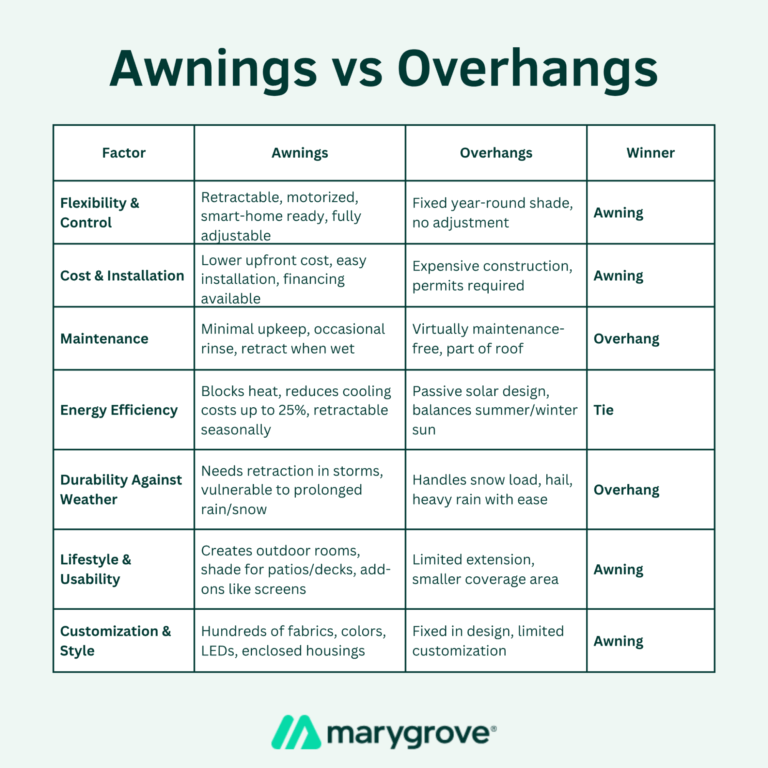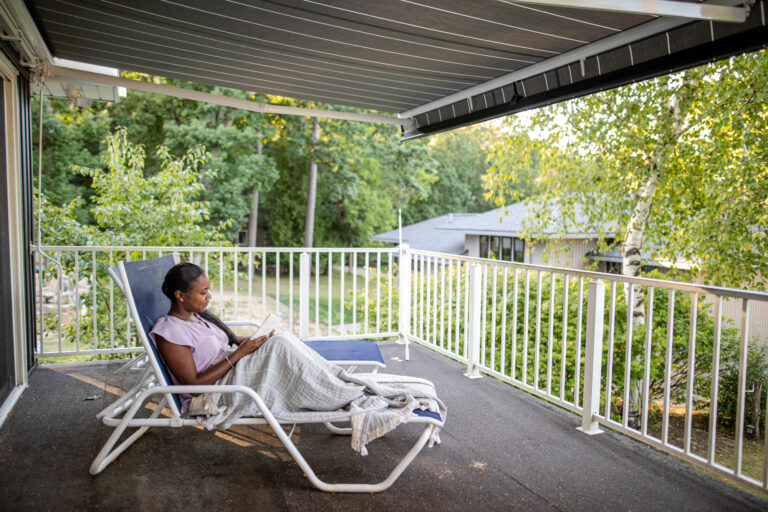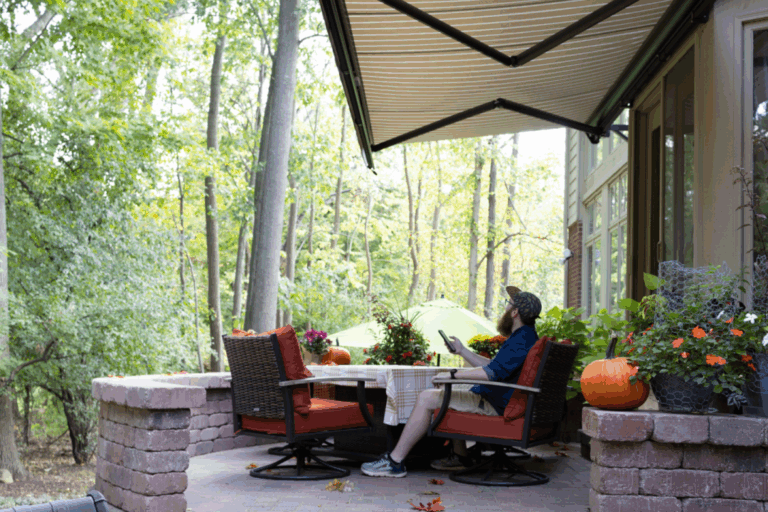An awning is a flexible add-on that retracts or extends for shade, while an overhang is a permanent roof extension. Awnings bring customization and control, overhangs offer built-in durability with minimal upkeep.
Awning vs Overhang: Defining the Real Difference for Homeowners
The key difference between awnings and overhangs is flexibility versus permanence.
Awnings are adjustable fabric coverings for controlled shade, while overhangs are fixed roof extensions offering year-round protection. Here’s the quick breakdown:
- Awnings: Retractable, customizable, budget-friendly, smart-home compatible, lifestyle oriented
- Overhangs: Permanent, architectural, low-maintenance, durable in heavy snow or hail
For most homeowners, awnings shine when retrofitting patios, decks, or windows where flexibility matters, while overhangs win during new construction or in regions that demand long-term structural strength.
Both have value, but your climate, budget, and goals will determine the right fit.
If you want to transform your outdoor space, start by understanding the difference between an awning and an overhang.
The right choice can boost comfort, save energy, and add long-term value to your home.
By digging deeper into cost, durability, usability, and customization, you’ll see why this decision is more than just shade.
Stay with us as we compare both options across real-world factors that directly affect daily living.
The Real Meaning Behind “Awning vs Overhang”

Before comparing the two, it helps to first understand what we actually mean by an awning and an overhang.
The terms are often used interchangeably, but in reality they represent two very different approaches to outdoor shade.
Both create comfort and protection, yet the way they are built and function sets them apart.
What is an Awning?
An awning is a secondary covering mounted to the exterior wall of a home or building.
It is usually made from fabrics like polyester, or vinyl-coated material stretched over a frame of aluminum, steel, or wood.
Awnings may be fixed in place or retractable, with retractable versions operated manually or motorized for convenience.
Modern awnings also come in a wide range of patterns, colors, and features such as full-cassette housings, LED lighting, and side screens, giving homeowners both flexibility and style.
They’re often used to shade patios for dining or lounging by the pool, turning outdoor areas into comfortable, livable spaces.
What is an Overhang?
An overhang is a permanent extension of a roofline.
Built into the structure of the home, it cannot be adjusted or removed.
Overhangs provide steady protection from rain, snow, and sun, and because they are part of the roof, they blend seamlessly with the home’s architecture while requiring little maintenance.
Their fixed design, however, can limit effectiveness against wind-driven rain or angled sunlight.
Why the Comparison Matters
Though both extend outward to shield outdoor areas, awnings are flexible add-ons while overhangs are permanent architectural elements.
This distinction influences cost, aesthetics, energy efficiency, and durability across different climates, making the comparison an important one.
By defining both clearly, it becomes clear that awnings and overhangs are not interchangeable but distinct shade strategies.
Next, we can explore how they compare across practical, real-world factors like weather performance, design, and usability.
Helpful Resource → How Awnings Reduce Heat: Smart Shade for Cooler Homes
How Awnings and Overhangs Compete Across 7 Practical Factors

When deciding between an awning or an overhang, it helps to look beyond definitions and see how each performs in everyday scenarios.
Below are seven practical factors where the two solutions compete head-to-head.
1. Flexibility and Control Over Shade
Shade needs change with the time of day and season, which makes flexibility a major deciding factor.
- Awning: Retractable awnings can be extended when the sun is harsh and retracted to allow light in cooler months. Motorized options integrate with remotes, apps, and even smart-home systems, offering total control.
- Overhang: Overhangs provide the same level of shade year-round. While reliable, they cannot be adjusted to let in more or less sun as conditions change.
Winner: Awning, because it adapts to shifting weather and homeowner preferences.
2. Cost and Installation Effort
Budget and project scope often play a large role in the decision.
- Awning: Generally more affordable, awnings can be installed without altering the roofline. Manual models are cost-effective, while motorized versions offer premium features at a higher but still manageable price. Financing options add accessibility.
- Overhang: Extending or adding an overhang requires significant construction, permits, and roofing expertise. This drives up both cost and installation time.
Winner: Awning, because it provides shade solutions at a fraction of the investment required for overhangs.
Helpful Resource → How Much Do Retractable Awnings Cost in 2025? [Full Pricing Guide]
3. Maintenance Requirements
Homeowners often underestimate how upkeep impacts the long-term experience of shade structures.
- Awning: Modern awnings require little effort. An occasional rinse and retracting when wet usually prevent issues, while enclosed housings protect the fabric. Over time, fabrics or motors may need light attention, but overall upkeep is simple.
- Overhang: As part of the roof, overhangs require little to no maintenance beyond standard roof inspections. Once constructed, they offer decades of reliable shade without additional effort.
Winner: Overhang, because its structural permanence makes it virtually maintenance-free, though maintaining an awning is not a significant challenge for most homeowners.
4. Energy Efficiency and Indoor Comfort
Shade impacts not only outdoor living but also indoor cooling needs.
- Awning: Awnings block sunlight before it reaches windows, reducing solar heat gain by up to 65–77% depending on orientation. Retractable designs also allow seasonal adjustment.
- Overhang: With proper placement, overhangs block high summer sun but still let in lower winter rays, balancing passive heating and cooling.
Winner: Tie, because both offer strong energy savings in different ways.
5. Durability Against Weather
Weather performance is crucial, especially in regions with heavy snow or rain.
- Awning: While sturdy, awnings need retraction during storms. Newer models have wind sensors that auto-close, but fabric is still vulnerable in prolonged rain or snow.
- Overhang: As part of the roof, overhangs handle snow load, hail, and rain without issue. They require no adjustments and stand firm for decades.
Winner: Overhang, because structural integration makes them far stronger in extreme conditions.
6. Outdoor Lifestyle and Usability

The right shade solution can transform how often and how comfortably outdoor spaces are used.
- Awning: Awnings create full outdoor rooms or even offices, covering patios or decks with customizable shade. Add-ons like retractable screens enhance privacy and wind protection.
- Overhang: While dependable, overhangs often extend only a few feet, leaving larger spaces unprotected and limiting use during angled rain or intense sun.
Winner: Awning, because it turns exposed areas into comfortable living spaces.
7. Customization and Style Options
Personalization is important for homeowners who want shade that matches their lifestyle and taste.
- Awning: Available in hundreds of fabrics, colors, and frame styles. Options like LED lights, enclosed housings, and smart sensors add both function and longevity.
- Overhang: Fixed in material and size. Customization depends on roof design and is limited compared to awnings.
Winner: Awning, because it offers nearly unlimited style and feature choices.
Across seven factors, awnings win in four categories, overhangs in two, with one tie.
Awnings excel in flexibility, affordability, lifestyle impact, and customization, while overhangs dominate in structural durability and low maintenance.
Both have unique advantages, but the right choice depends on what matters most to the homeowner.
Who Truly Benefits From Awnings vs Overhangs?

Both awnings and overhangs bring value, but they serve different homeowners best depending on goals, climate, and how the space will be used.
Awnings are ideal for homeowners who:
- Want flexible control over shade with retractable or motorized options
- Prefer a faster, less invasive installation that doesn’t require altering the roofline
- Need a retrofit solution when existing overhangs are too short to block angled sun or wind-driven rain
- Desire outdoor lifestyle upgrades, like turning a bare patio into a shaded dining or entertaining space
- Value customization with fabrics, colors, lighting, and smart-home integration
Overhangs are best suited for homeowners who:
- Are building a new home where the overhang can be seamlessly designed into the roofline
- Want a permanent architectural feature that blends naturally with the home’s style
- Live in regions with heavy snow or hail, where structural durability is critical
- Prefer low-maintenance solutions that require little beyond routine roof care
While overhangs provide permanence and structural strength, awnings offer flexibility and lifestyle advantages.
Some homeowners worry that adding an awning to a home with short soffits might look mismatched, but modern designs are sleek enough to complement most exteriors.
The right fit depends less on terminology and more on what shade solution enhances your daily living.
Also Read → Best Shade Solution: Awnings or Patio Umbrellas?
Seven Factors That Determine the Right Shade Solution for You
Luscri Family Retractable Awning Testimonial
Choosing between an awning and an overhang often comes down to how each option fits your unique circumstances.
These seven factors can help clarify the decision.
- Local Weather Extremes (Neutral): In regions with heavy snow or hail, overhangs provide structural reliability. Awnings work well in variable climates but should be retracted during storms to preserve fabric life.
- Budget and Long-Term ROI: Awnings are budget-friendly and often come with financing, while overhangs demand costly construction but add lasting structural value.
- Smart-Home Integration: Motorized awnings can be controlled by remotes, apps, or even voice assistants. Built-in sensors retract them automatically in strong winds, making them a future-proof solution.
- Design Harmony With Your Home: Overhangs naturally blend with architecture, while awnings require thoughtful selection. However, modern full-cassette awnings and sleek fabric choices make them visually appealing too.
- Maintenance Expectations: Overhangs require little beyond roof care. Awnings, once thought high-maintenance, now feature mildew-resistant fabrics and enclosed housings, keeping upkeep simple.
- Lifestyle Goals: Awnings transform bare patios into shaded extensions of the home, perfect for meals, reading, or social gatherings. Overhangs, while reliable, often cover less usable space.
- Local Building Codes: Extending roof overhangs may conflict with zoning rules, while awnings, being non-structural, typically avoid such hurdles.
In the end, both awnings and overhangs have their strengths.
Overhangs deliver structural reliability with little upkeep, while awnings bring flexibility and lifestyle benefits.
The right choice comes down to what matters most in your daily outdoor living.
Also Read → Fixed vs Retractable Awnings: Pros, Cons & Smart Comparisons
Creating the Perfect Balance: Combining Awnings and Overhangs
Awnings and overhangs don’t have to compete, they can work together to create a backyard that’s functional year-round.
By combining permanent architectural shade with flexible, retractable coverage, homeowners can enjoy the best of both worlds in comfort and design.
What Awnings Offer:
- Adjustable shade that extends or retracts as sunlight and seasons change
- A wide range of styles, fabrics, and smart features for added convenience
- The ability to cover larger spaces like patios, decks, or poolside areas
- Retractable control to enjoy sunlight when desired or protection when needed
What Overhangs Offer:
- Built-in, permanent protection integrated into the home’s roofline
- Structural strength that stands up to snow, rain, and strong winds
- Minimal maintenance with a design that lasts for decades
- Seamless visual connection between indoor and outdoor spaces
Used together, awnings and overhangs create balance, permanent shelter where it’s needed most, and flexible shade when the weather demands it.
The result is a backyard that feels cohesive, comfortable, and ready for every season.
Finding the Right Shade for Your Home

Awnings and overhangs may both shield your outdoor spaces, but they serve different priorities.
Overhangs bring structural strength and low upkeep, while awnings offer flexibility, smart features, and lifestyle-focused design.
Homeowners can choose the option that best fits their climate, budget, and goals.
Or, with thoughtful planning and the right budget, combine both to create a perfectly balanced shade solution that works all year long.
Ready to enhance your outdoor living?
Marygrove’s professionally installed retractable awnings bring flexibility, comfort, and long-lasting value to your home.
Contact us today for a free consultation and discover the shade solution made for your lifestyle.

